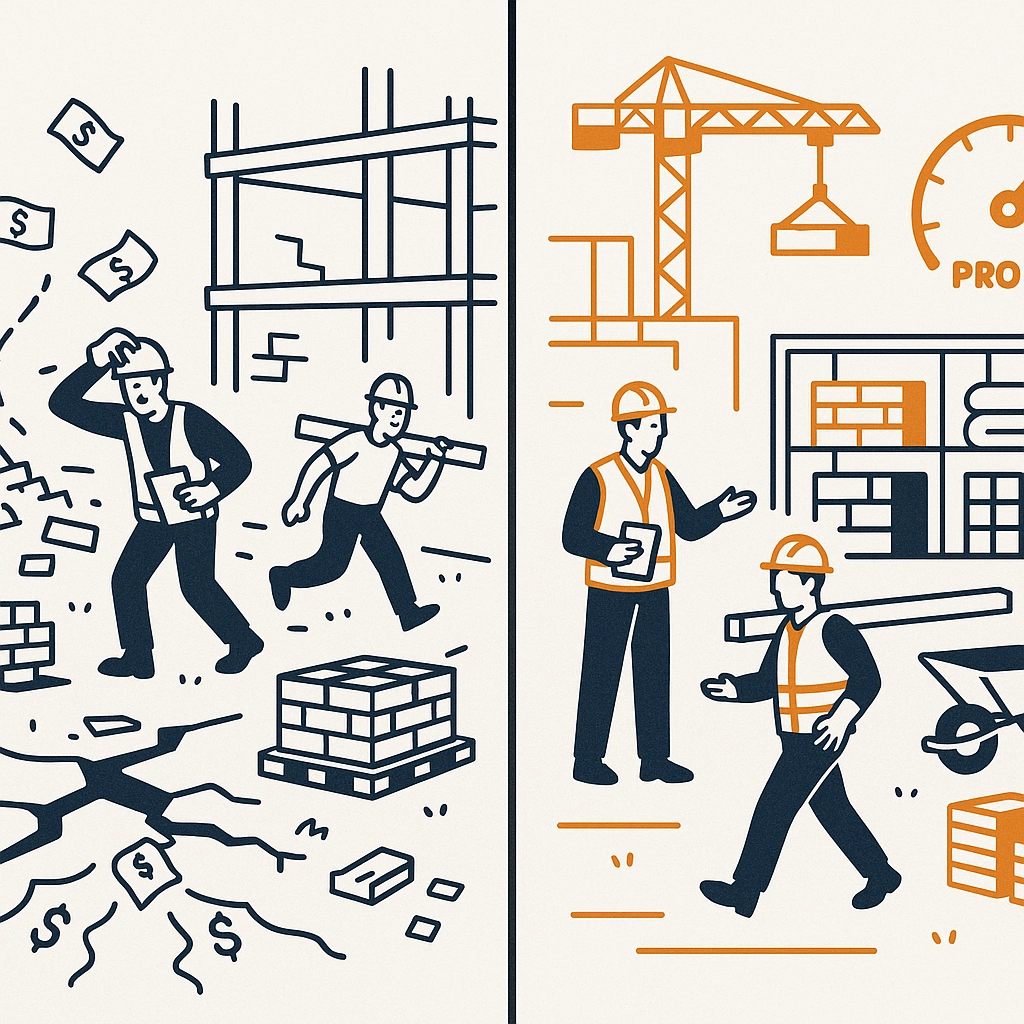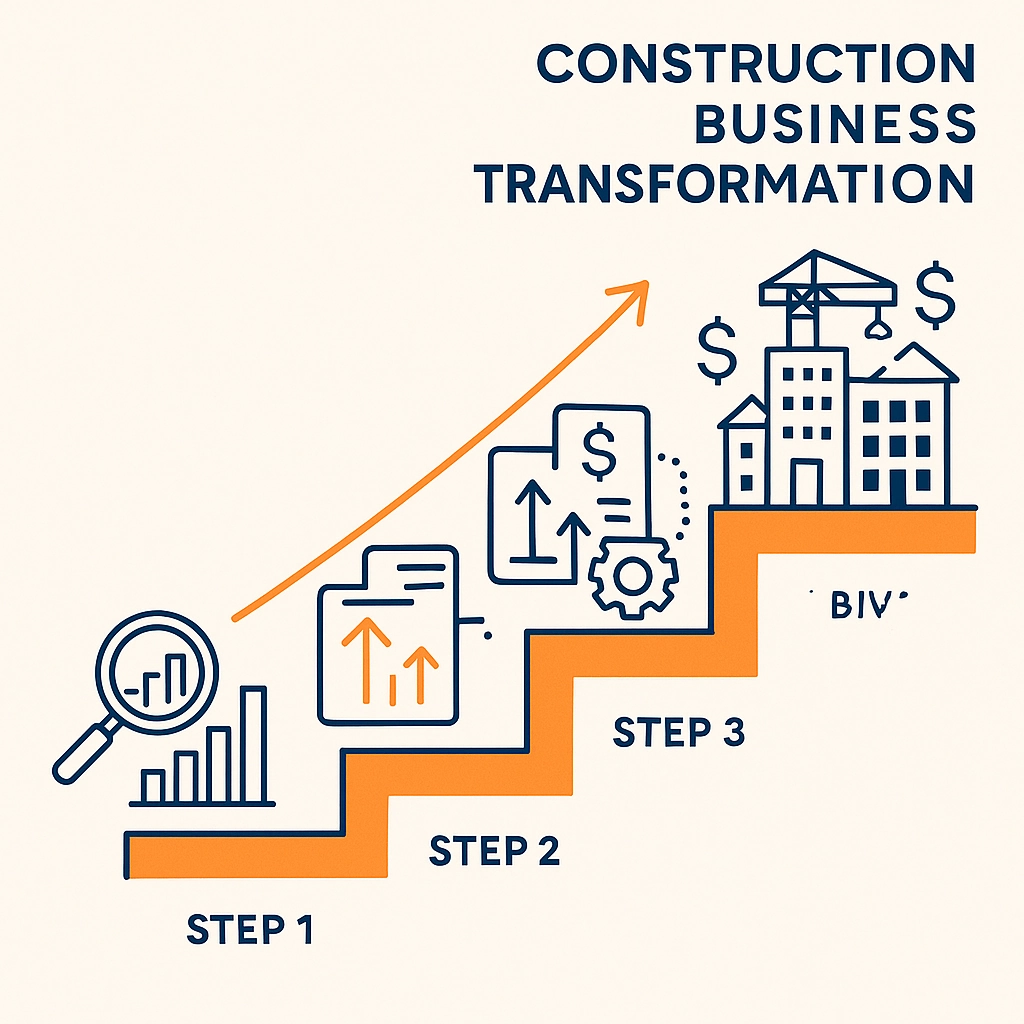
Doubling Your Construction Profits Without Doubling Your Hours—Is It Really Possible?
The Million-Dollar Question for Contractors
If you're like most contractors I work with, you're probably stuck in a frustrating cycle: more profit requires more hours, more hours means more burnout, and eventually, you hit a ceiling on both. You're left wondering if there's a way to break free from this trap without sacrificing your business or sanity.
The short answer? Yes, it's absolutely possible to double your construction profits without doubling your hours. But it requires a fundamental shift in how you approach your business.
At Hammer & Grind, we've helped hundreds of contractors transform their operations from time-for-money grinders into profit-generating machines. Let's dive into exactly how they did it—and how you can too.
Why Most Contractors Get Stuck on the Profit Treadmill
Before we talk solutions, let's get real about the problem. Most construction businesses operate on a simple but flawed equation:
This linear thinking creates an inevitable bottleneck. There are only so many hours in a day, and eventually, you reach maximum capacity. When that happens, your options seem limited:
Work yourself to death
Hire more people (and deal with all the headaches that brings)
Accept that you've hit your profit ceiling
But what if there was a fourth option?
The Profit Multiplier Framework
The contractors who successfully double profits without doubling hours focus on five key leverage points:
1. Strategic Pricing: Charge What You're Worth
Most contractors undercharge. Period. They price based on what competitors charge or what "feels right" rather than what delivers actual profit.
The fix? Implement value-based pricing that reflects:
Your expertise and quality
The true costs of your business (including your management time)
A healthy net profit margin (aim for 20-25% net, not 10%)
One Hammer & Grind client increased his prices by 20% and lost only one potential customer—while increasing his net profit margin from 12% to 28% overnight.
Action step: Review your last 10 projects. For each one, calculate your actual hourly rate (profit ÷ hours). Then ask: "Would I take on this exact project again at this rate?" If the answer is no, it's time to adjust your pricing.
2. Eliminate Profit Leaks Through Process Optimization

The average construction project loses 20-30% of potential profit through waste:
Unnecessary material purchases
Inefficient crew scheduling
Scope creep without compensation
Rework due to poor communication
By implementing tight processes, you can capture this lost profit without working additional hours.
A systematic approach includes:
Detailed, non-negotiable contracts with change order protocols
Digital documentation of all project changes
Weekly project reviews to catch issues before they become expensive
Standardized material ordering to reduce waste
Real example: Ben used to show up to every job and verbally tell his team what needed to be done. This required him to waste precious time each day. He switched to a project management software and issues work orders for his team. Now he doesn't have to go to each job. Precious time saved for the owner and less communication errors do to remembering details.
3. Leverage Technology as Your "Digital Employee"
The right technology functions like an additional team member who works 24/7 without complaining or taking breaks.
High-leverage tech investments include:
Project management software that automates scheduling and communication
Estimating tools that increase accuracy and save prep time
GPS time tracking to reduce labor waste
Customer relationship management (CRM) systems to improve sales conversion
Pro tip: Don't just buy technology—commit to mastering it. A partially implemented system often creates more problems than it solves.
Check out our recommended tools for contractors at https://www.hammerandgrind.com/software
4. Build Systems That Scale Without You

The secret to breaking the hours-for-money trap? Creating systems that generate profit whether you're on site or not.
This means:
Documented processes that anyone can follow
Training programs that quickly bring new hires up to speed
Management structures that don't require your constant presence
Quality control checkpoints at every project stage
Case study: Brendan, a Hammer & Grind client, created detailed process documents for his five most common project types. Within six months, he reduced his on-site hours by 60% while maintaining quality and increasing profit margins by 15%.
Learn more about getting "off the tools" with our free webinar: https://www.hammerandgrind.com/optin-off-the-tools-webinar
5. Focus on High-Margin Work and Strategic Outsourcing
Not all construction work is created equal when it comes to profitability. The contractors who double profits without doubling hours become extremely selective about the projects they take on.
They also strategically outsource low-margin tasks while keeping high-margin work in-house.
Consider this profit hierarchy:
Highest margin: Specialized work where you have unique expertise and minimal competition
Medium margin: Standard work that requires skilled labor but faces more competition
Lowest margin: Basic work that many competitors can perform
Strategy shift: Instead of taking any project that comes your way, focus on winning more tier-one projects and outsourcing tier-three work to subcontractors.
The Four-Step Implementation Plan

Transforming your business doesn't happen overnight. Here's the roadmap our most successful clients follow:
Step 1: Audit Your Current Profitability (Week 1)
Calculate your true hourly profit for each recent project
Identify your highest and lowest profit types of work
Pinpoint where most of your time goes vs. where most of your profit comes from
Step 2: Fix Your Pricing and Proposals (Week 2)
Revise your pricing structure to reflect actual costs plus healthy profit
Implement non-negotiable change order processes
Create proposal templates that highlight value, not just price
For a free guide on construction sales strategies that protect your margins, visit https://www.hammerandgrind.com/sales-training-optin.
Step 3: Implement Core Systems (Months 2-3)
Choose and set up your essential technology stack
Document your most common processes
Train your team on new systems and expectations
Establish weekly profit review meetings
Step 4: Optimize and Scale (Months 4-6)
Begin strategic outsourcing of low-margin work
Focus marketing efforts on attracting high-margin projects
Create additional profit centers that don't require your direct labor
Implement team incentives tied to profit, not just revenue
Is This Really Possible for Your Business?
You might be thinking, "Sure, this sounds great in theory, but will it work for MY construction business?"
The evidence says yes. At Hammer & Grind, we've seen contractors across specialties—from residential remodelers to commercial builders, from plumbers to landscapers—successfully implement these strategies.
The common denominator isn't their trade or market size. It's their willingness to think differently about the relationship between time and money.
As one client put it: "I spent 15 years thinking I had to choose between profit and freedom. Turns out I just needed better systems."
Your Next Steps
If you're ready to break free from the hours-for-profit trap:
Start with one area. Don't try to overhaul everything at once. Pick the strategy that seems most immediately applicable to your business.
Measure relentlessly. Track your profit per hour before and after implementing changes. Data will tell you what's working.
Get support. Transforming your business model is challenging work. Consider joining our Profit Club where you'll find guidance and accountability.
The bottom line? Doubling your profits without doubling your hours isn't just possible—it's the only sustainable path forward for contractors who want both financial success and a life beyond work.
Ready to take the first step? Schedule a free strategy call to see if our approach might be right for your business: https://www.hammerandgrind.com/application
